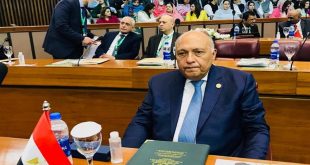Further military escalation between India and Pakistan over Kashmir could be the prelude to an apocalyptic clash that would destroy both countries
Hani Ghoraba
A border clash or army skirmishes between two nations that have experienced years of hostilities may be the most common way to start a war. As a state of no-peace, no-war has been on-going for decades between India and Pakistan; some observers have been expecting the worst to occur any day. It has been simply a matter of when.
The spark for the recent military exchanges between India and Pakistan came when 40 Indian paramilitary police in Pulwama in Kashmir were killed in one of the deadliest terrorist attacks in the area in years. India blamed Pakistan for harbouring and supporting the terrorist-designated Jaish e-Mohamed group in Pakistan that declared responsibility for the attack.
In retaliation, India launched an air strike inside Pakistan targeting the terrorist group’s camps and killing many Jaish e-Mohamed fighters, according to Indian sources. Pakistan retaliated by shooting down two Indian air force fighters and capturing one of its pilots who was released from custody some days later. Despite this peaceful gesture by Pakistan, it nevertheless violated the ceasefire by shelling the Nowshera region from across the border, killing four people including a woman and two children.
According to Indian sources, Pakistan has violated the ceasefire between the two countries nearly 3,000 times over the last 15 years through the artillery and mortar shelling of Indian-controlled regions.
The predominantly Muslim-populated Kashmir province has been a point of struggle between the two countries since the 1947 Indo-Pakistani War that saw Pakistan-supported rebels attempting to take over the province that had pledged allegiance to India through its former ruler, the maharaja Hari Singh, despite its Muslim-majority yet secular population. Since that date, Kashmiri insurgents backed by Pakistan have fought battles against the Indian rule of 43 per cent of Kashmir, especially in the areas of Jammu, the Kashmir Valley, and the Siachen glaciers. Wars erupted in 1947, 1965 and 1999 over control of the region.
The latest conflict in 1999 witnessed Pakistani soldiers disguised as Kashmiri insurgents attempting to seize control of areas of the Indian-controlled Kargil region. The Indian army backed by the Indian air force managed to recapture all the regions initially controlled by Pakistani forces, with these withdrawing under the strong counter-attack of the Indian military and international pressure.
The region has witnessed over 10 massive terrorist attacks since 1989, but the one in February 2019 remains the deadliest over the past three decades carried out against Indian targets by the likes of the Jaish e-Mohamed and Lashkar e-Taiba terrorist groups operating mainly from Pakistan.
However, blaming the Pakistani government and security apparatuses for harbouring terrorist groups is not new. Pakistani intelligence was deeply involved in the formation of the mujahideen groups in Afghanistan during the Soviet invasion and occupation of Afghanistan from 1979 to 1989. A US CIA operation called Operation Cyclone aimed to channel funds to Afghan mujahideen fighting the Soviets, using Pakistani intelligence to do so. Many of these mujahideen leaders later formed the infamous terrorist group Al-Qaeda in 1988.
The ties that link Pakistan with some Al-Qaeda and other radicals have been proven time and time again. It is not a coincidence that former Al-Qaeda leader Osama bin Laden chose Pakistan as his last hideout before his killing in the Pakistani region of Abbottabad after a decade-long hunt by the US army in neighbouring Afghanistan. The Pakistanis denied having had any knowledge of Bin Laden’s being on their soil at the time.
Meanwhile, both India and Pakistan are nuclear powers with some international recognition of their nuclear arsenals even though they do not have full recognition as members of the nuclear club. Both countries have amassed sizeable nuclear arsenals of at least 100 nuclear warheads each.
In a message to Indian leaders, Pakistani Prime Minister Imran Khan warned of the terrible consequences of an escalating war between the two countries if matters got out of control as a result of the nuclear arsenals both countries carry. In the same televised statement, Khan called for an open dialogue with India about the de-escalation of the situation in Kashmir.
Indian Prime Minister Narendra Modi, facing re-election in the upcoming general elections in India in April and May, cannot afford to be seen as complacent or lax on national security issues, however, especially against Pakistan. He thus took the bold decision to take the fight against terrorism onto Pakistani soil, though clearly it will not boost his chances for re-election if he takes his country into a full-scale war with Pakistan, endangering the very existence of his country and that of Pakistan if the situation escalates further.
Indian and Pakistani military capabilities up the ante of any possible war occurring between the two countries in the future. Both countries have growing populations, with India’s estimated to reach nearly 1.35 billion and Pakistan’s 200 million this year. Any war between the two countries that might occur in the future would thus risk the lives of over a fifth of the world’s population.
Militarily, India has a qualitative edge over Pakistan, with an arsenal containing state-of-the-art Western, Russian, and indigenous weaponry. The country’s military strength is ranked fourth globally, next to that of the US, Russia and China. The Indians are able to field as many as 10 times the number of soldiers as Pakistan, given the country’s population advantage. However, the Pakistani army is battle-hardened and experienced, and it has decades of experience as a force to be reckoned with, especially given its excellent aerial and missile capabilities backed by mostly US along with indigenous armaments. Such considerations mean that India will have a very hard time tackling Pakistan.
A war between India and Pakistan would produce a zero-sum result as both countries have the capability to inflict massive damage on the other, especially if the situation reached the critical point of using non-conventional weapons. Such a war could draw other belligerents to enter the fray, including the US, Russia, and China, all of which have strong ties with one or both countries, thus potentially creating the conditions for a conflict of a size not seen since World War II.
That said, there is an awareness of the gravity of the situation in both countries, which, despite showing a hostile stance towards the other, remain grounded in their common ambition to solve the Kashmiri issue without the use of military means. While some analysts have downplayed the possible use of nuclear armaments in any future conflict, this analysis does not factor in the possibly extreme measures that could be taken if one of the countries felt it was at risk of being overrun by the other or was about to lose the war.
The volatile situation in Kashmir will remain a ticking bomb set to explode and ignite a possible major war between India and Pakistan in the future. Both countries must realise that solving the crisis by military means is very far from being an optimum solution. As a result, Modi may opt to take Khan’s call for negotiations seriously after assurances that Pakistan is keeping the Kashmiri terrorist groups on a tight leash.
However, this may be hard to do for Pakistan, as the country’s security forces have been fighting Al-Qaeda elements on Pakistani territory near Peshawar for decades to no avail. But with a limited hope of reaching a working peace agreement over Kashmir, the option of keeping Al-Qaeda and other elements under tight control remains the only sane option to take by both sides. Any military escalation would simply be the prelude to an apocalyptic clash that would destroy them both.
The writer is a political analyst and author of Egypt’s Arab Spring and the Winding Road to Democracy.
From: Al-Ahram Weekly






